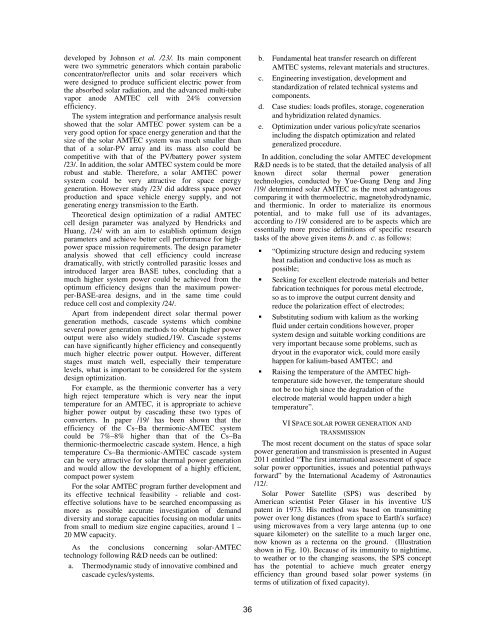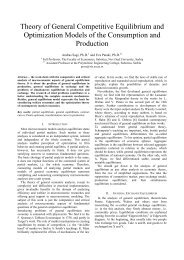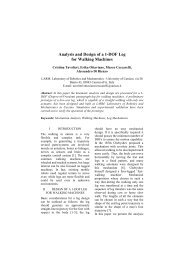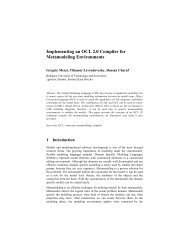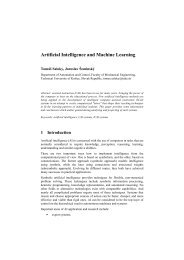developed by Johnson et al. /23/. Its main componentwere two symmetric generators which contain parabolicconcentrator/reflector units and solar receivers whichwere designed to produce sufficient electric power fromthe absorbed solar radiation, and the advanced multi-tubevapor anode AMTEC cell with 24% conversionefficiency.The system integration and performance analysis resultshowed that the solar AMTEC power system can be avery good option for space energy generation and that thesize of the solar AMTEC system was much smaller thanthat of a solar-PV array and its mass also could becompetitive with that of the PV/battery power system/23/. In addition, the solar AMTEC system could be morerobust and stable. Therefore, a solar AMTEC powersystem could be very attractive for space energygeneration. However study /23/ did address space powerproduction and space vehicle energy supply, and notgenerating energy transmission to the Earth.Theoretical design optimization of a radial AMTECcell design parameter was analyzed by Hendricks andHuang, /24/ with an aim to establish optimum designparameters and achieve better cell performance for highpowerspace mission requirements. The design parameteranalysis showed that cell efficiency could increasedramatically, with strictly controlled parasitic losses andintroduced larger area BASE tubes, concluding that amuch higher system power could be achieved from theoptimum efficiency designs than the maximum powerper-BASE-areadesigns, and in the same time couldreduce cell cost and complexity /24/.Apart from independent direct solar thermal powergeneration methods, cascade systems which combineseveral power generation methods to obtain higher poweroutput were also widely studied./19/. Cascade systemscan have significantly higher efficiency and consequentlymuch higher electric power output. However, differentstages must match well, especially their temperaturelevels, what is important to be considered for the systemdesign optimization.For example, as the thermionic converter has a veryhigh reject temperature which is very near the inputtemperature for an AMTEC, it is appropriate to achievehigher power output by cascading these two types ofconverters. In paper /19/ has been shown that theefficiency of the Cs–Ba thermionic-AMTEC systemcould be 7%–8% higher than that of the Cs–Bathermionic-thermoelectric cascade system. Hence, a hightemperature Cs–Ba thermionic-AMTEC cascade systemcan be very attractive for solar thermal power generationand would allow the development of a highly efficient,compact power systemFor the solar AMTEC program further development andits effective technical feasibility - reliable and costeffectivesolutions have to be searched encompassing asmore as possible accurate investigation of demanddiversity and storage capacities focusing on modular unitsfrom small to medium size engine capacities, around 1 –20 MW capacity.As the conclusions concerning solar-AMTECtechnology following R&D needs can be outlined:a. Thermodynamic study of innovative combined andcascade cycles/systems.b. Fundamental heat transfer research on differentAMTEC systems, relevant materials and structures.c. Engineering investigation, development andstandardization of related technical systems andcomponents.d. Case studies: loads profiles, storage, cogenerationand hybridization related dynamics.e. Optimization under various policy/rate scenariosincluding the dispatch optimization and relatedgeneralized procedure.In addition, concluding the solar AMTEC developmentR&D needs is to be stated, that the detailed analysis of allknown direct solar thermal power generationtechnologies, conducted by Yue-Guang Deng and Jing/19/ determined solar AMTEC as the most advantageouscomparing it with thermoelectric, magnetohydrodynamic,and thermionic. In order to materialize its enormouspotential, and to make full use of its advantages,according to /19/ considered are to be aspects which areessentially more precise definitions of specific researchtasks of the above given items b. and c. as follows:“Optimizing structure design and reducing systemheat radiation and conductive loss as much aspossible;Seeking for excellent electrode materials and betterfabrication techniques for porous metal electrode,so as to improve the output current density andreduce the polarization effect of electrodes;Substituting sodium with kalium as the workingfluid under certain conditions however, propersystem design and suitable working conditions arevery important because some problems, such asdryout in the evaporator wick, could more easilyhappen for kalium-based AMTEC; andRaising the temperature of the AMTEC hightemperatureside however, the temperature shouldnot be too high since the degradation of theelectrode material would happen under a hightemperature”.VI SPACE SOLAR POWER GENERATION ANDTRANSMISSIONThe most recent document on the status of space solarpower generation and transmission is presented in August2011 entitled “The first international assessment of spacesolar power opportunities, issues and potential pathwaysforward” by the International Academy of Astronautics/12/.Solar Power Satellite (SPS) was described byAmerican scientist Peter Glaser in his inventive USpatent in 1973. His method was based on transmittingpower over long distances (from space to Earth's surface)using microwaves from a very large antenna (up to onesquare kilometer) on the satellite to a much larger one,now known as a rectenna on the ground. (Illustrationshown in Fig. 10). Because of its immunity to nighttime,to weather or to the changing seasons, the SPS concepthas the potential to achieve much greater energyefficiency than ground based solar power systems (interms of utilization of fixed capacity).36
Figure 10. . SPS Concept illustration - 1973 US Patent No. 5019768.The SPS concept has been the subject of numerousnational systems studies and technology developmentefforts from 1970 to 2010 (included efforts in the US,Canada and Europe, as well as steady technology R&D inJapan, and more recent activities in China and India /12/.Because significant advances in space solar power couldhave profound benefits for human and robotic spaceexploration capabilities as well as other spaceapplications, the study /12/ also identified suchopportunities and evaluated the potential for synergiesbetween these benefits for space missions and space solarpower for terrestrial markets /12/.Three highly promising SPS platform concepts wereexamined by the IAA study /12/. All three examinedcases were geostationary Earth orbit-based SPS concepts;these were /12/: An updated version of the microwave wirelesspower transmission (WPT) 1979 SPS ReferenceSystem concept, involving large discrete structures(e.g., solar array, transmitter, etc.) assembled by aseparate facility in space;Modular electric/diode array laser WPT SPSconcept, involving self assembling solar powerlaser-thermalmodules of intermediate scale; and Extremely modular microwave WPT SPS“sandwich structure” concept, involving a largenumber of very small solar power-microwavethermalmodules that would be roboticallyassembled on orbit.A few alternative space solar power (SSP) conceptswere also identified but not analyzed /12/ (low Earthorbit-based “Sun Tower” SPS concept, lunar solar power,etc).Papers (/16/-/22/) present insight in, and developmentoverview of the advanced space/terrestrial powergeneration device: AMTEC.An AMTEC converter was under development for usein the AMTEC Radioisotope Power System (ARPS)program (collaboration between DOE and NASA) /22/.<strong>Program</strong> goal was to develop the new generation ofthermal to electric power conversion systems for use indeep space probes. The advantageous AMTEC feature forspace operation is that it has no moving parts. By theradioisotope powered AMTEC produces electric energythrough the interaction of its two main components: theradioactive heat source (fuel and containment) and thethermoelectric generator. Radioactive material used forfuel spontaneously disintegrates into a different atomicform dissipating - producing heat, which AMTECconverts into electricity. The prime system contractor wasLockheed Martin Corporation, with Advanced ModularPower Systems, Inc. (AMPS) responsible for thedevelopment of the AMTEC converter /22/.The most recent development of space solar powertechnologies reviews Japanese paper /13/, and earlierreviews of all relevant known technologies present papers( /17/, /19/-/21/). Particularly important papers relevantfor the wireless transmission of space “produced energy”to Earth are those treating broad spectral range of energywavestransmission methods and technologies as /14/,/15/, /16/ and /18/.Recognizing the spin-off impact of new technologies,especially those space-based as solar power, Chinarecently unveiled a plan to build and orbit a solar powerstation for commercial use by 2040 /19/. The Chineseplan drawn by one of its space pioneers Wang Xiji is anambitious one and aims to look at various aspects ofspace-based solar power applications, designs and keytechnologies which could make the option economicallyfeasible in the first instance and sustainable by 2020.Detailing the research conducted by the ChinaAcademy of Sciences, Wang said /19/ at the fourth ChinaEnergy Environment Summit Forum:"The developmentof solar power station in space will fundamentally changethe way in which people exploit and obtain power.Whoever takes the lead in the development andutilization of clean and renewable energy and the spaceand aviation industry will be the world leader."While China's lead in the SBSP could provide for a cooperativeframework in Asia, there lies a strongimperative also for India and other particularly growingeconomies endangered with energy shortages to cometogether and realize the SBSP utilization dream.Other countries like Japan have also done considerableresearch in this field. Japan's Aerospace ExplorationAgency has done decade-long research on SBSP incollaboration with high-end technological companiessuch as Mitsubishi. Collaboration among these countrieswould also facilitate funding for this ambitious project.The actual beginning of the realization of the SBSP isassociated with the further development of the existingspace and wireless industry, development of relatednew branches that will emerge from current SBSPresearch and that must support the continuing survival ofSBSP and corresponding issues of energy andenvironmental security.VII WIRELESS ENERGY TRANSISSION STATUSApproaching concluding remarks of this study, wereviewed conclusions of the study /12/ relevant to thewireless energy transmission (WET) technology.The report /12/ is the most recent comprehensivedocument presenting status of the WET or WPT (wirelesspower transmission) technology. Prepared implementingreadiness and risk assessment methodology it used as therelevant indicators on the technology maturity and riskfollowing quantities: Technology Readiness Levels (TRLs), and37
- Page 1 and 2: 4 4 th IEEE International Symposium
- Page 3 and 4: EXPRES 20124 th International Sympo
- Page 5 and 6: Application of Thermopile Technolog
- Page 7 and 8: Design of a Solar Hybrid System....
- Page 9 and 10: ___________________________________
- Page 11 and 12: environmental protection and global
- Page 13 and 14: But can we use the human body sweat
- Page 15 and 16: IX. REFERENCES[1] Todorovic B. Cvje
- Page 17 and 18: QQ⎛ Λt⎞=⎜⎟⎝ Λ ⎠Nt Nwh
- Page 19 and 20: Analysis of the Energy-Optimum of H
- Page 21 and 22: V. OBJECTIVE FUNCTIONThe objective
- Page 23 and 24: The Set-Up Geometry of Sun Collecto
- Page 25 and 26: continuous east-west sun collector
- Page 27 and 28: continuously measure the thermal ch
- Page 29 and 30: CEvaluation of measurement resultsA
- Page 31 and 32: Application of Thermopile Technolog
- Page 33 and 34: Temperature of the components [C]90
- Page 35 and 36: nighttime, to weather or to the cha
- Page 37: η uη u0.50.40.30.20.1T 1 - 400K0.
- Page 41 and 42: [16] Zoya B. Popović: Wireless Pow
- Page 43 and 44: 25.0020.0015.0010.005.000.00Figure
- Page 45 and 46: · ℃ 0.0738 · 1.209 0.0892
- Page 47 and 48: use may be advantageous not only in
- Page 49 and 50: To find the reasons for this disagr
- Page 51 and 52: Toward Future: Positive Net-Energy
- Page 53 and 54: EnergyPlus environment, we used mod
- Page 55 and 56: To keep future energy consumption d
- Page 57 and 58: A New Calculation Method to Analyse
- Page 59 and 60: On Fig. 3. can be seen the areas th
- Page 61 and 62: Present and Future of Geothermal En
- Page 63 and 64: TABLE II.THE TEMPERATURE DATA AND C
- Page 65 and 66: Error in Water Meter Measuring at W
- Page 67 and 68: III.RESULTS OF MEASURMENTSEach meas
- Page 69 and 70: TABLE I.THE AVERAGE VALUE OF THERMA
- Page 71 and 72: If the walls of the DHEs are made o
- Page 73 and 74: Environmental External Costs Associ
- Page 75 and 76: iodiesel production facility with a
- Page 77 and 78: Contribution of unit processesto ex
- Page 79 and 80: Heat Pump News in HungaryBéla Ád
- Page 81 and 82: Thermal Comfort Measurements In Lar
- Page 83 and 84: IV.DISCUSSIONThe sample frequencies
- Page 85 and 86: For a Clear View of Traditional and
- Page 87 and 88: esults in geographically distribute
- Page 89 and 90:
Design of a Solar Hybrid SystemMari
- Page 91 and 92:
Maintaining the set point temperatu
- Page 93 and 94:
Decision system theory model of ope
- Page 95 and 96:
parameter of pump in the function o
- Page 97 and 98:
Importance and Value of Predictive
- Page 99 and 100:
D. Overview of existing boiler oper
- Page 101 and 102:
HEAVY FUEL OIL FIRED, STEAMNATURAL
- Page 103 and 104:
MATHEMATICAL MODEL AND NUMERICAL SI
- Page 105 and 106:
C. Energy balance equationMathemati
- Page 107 and 108:
Discretization energy balance equat
- Page 109 and 110:
T ulf=32 º C, A - m =0.00162 kg/s,
- Page 111 and 112:
Comparison of Heat Pump and MicroCH
- Page 113 and 114:
the microCHP development. The energ
- Page 115 and 116:
control and stabilizer must be deve
- Page 117 and 118:
In Figure 1, in relation to the ord
- Page 119 and 120:
NPCC BHXOBYNI x1I x2I x3I x4LO YKYO
- Page 121 and 122:
exchange, as in reality, economies
- Page 123 and 124:
esponsibilities for consequences, o
- Page 125 and 126:
Coca-Cola Enterprise Inc had approx
- Page 127 and 128:
Flow Pattern Map for In Tube Evapor
- Page 129 and 130:
circumference with a liquid film. T
- Page 131 and 132:
Tube diameter: d 6 mm W Heat flux
- Page 133 and 134:
Realization of Concurrent Programmi
- Page 135 and 136:
applications the development, optim
- Page 137 and 138:
Renewable energy sources in automob
- Page 139 and 140:
commercial arrays can be built at b
- Page 141 and 142:
of multiple thin films produced usi
- Page 143:
EXPRES 20124 th International Sympo


